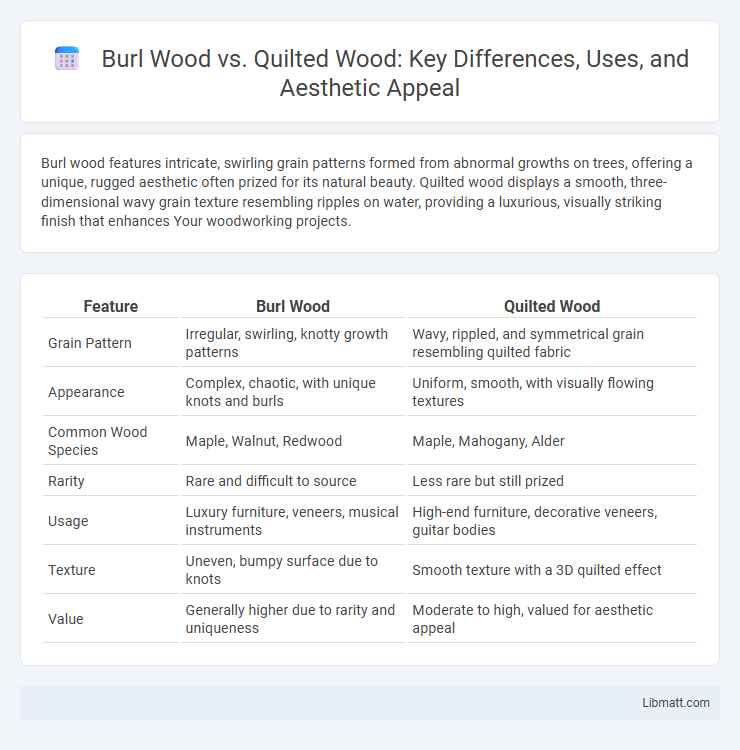Burl wood features intricate, swirling grain patterns formed from abnormal growths on trees, offering a unique, rugged aesthetic often prized for its natural beauty. Quilted wood displays a smooth, three-dimensional wavy grain texture resembling ripples on water, providing a luxurious, visually striking finish that enhances Your woodworking projects.
Table of Comparison
| Feature | Burl Wood | Quilted Wood |
|---|---|---|
| Grain Pattern | Irregular, swirling, knotty growth patterns | Wavy, rippled, and symmetrical grain resembling quilted fabric |
| Appearance | Complex, chaotic, with unique knots and burls | Uniform, smooth, with visually flowing textures |
| Common Wood Species | Maple, Walnut, Redwood | Maple, Mahogany, Alder |
| Rarity | Rare and difficult to source | Less rare but still prized |
| Usage | Luxury furniture, veneers, musical instruments | High-end furniture, decorative veneers, guitar bodies |
| Texture | Uneven, bumpy surface due to knots | Smooth texture with a 3D quilted effect |
| Value | Generally higher due to rarity and uniqueness | Moderate to high, valued for aesthetic appeal |
Introduction to Burl Wood and Quilted Wood
Burl wood features unique, swirling grain patterns caused by abnormal growths on trees, making each piece highly prized for its intricate and natural designs. Quilted wood is characterized by a three-dimensional, wavy grain pattern resembling ripples or quilted fabric, often found in maple and prized for its visual depth and texture. Both types of wood are sought after in fine woodworking and luxury furniture for their distinctive aesthetic qualities.
Defining Burl Wood: Characteristics and Formation
Burl wood is characterized by its unique swirling grain patterns and irregular growths formed from tree buds, often caused by stress, injury, or infection. These formations create dense clusters of small knots and knots inside, resulting in highly decorative and unpredictable grain patterns prized in woodworking. Burl wood is commonly sourced from species like redwood, walnut, and maple, valued for its rarity and striking aesthetic appeal in veneers and fine furniture.
Quilted Wood: Distinctive Features and Origins
Quilted wood is characterized by its unique, wavy grain pattern that creates a three-dimensional, rippled effect, predominantly found in maple species. This visually striking texture originates from irregular growth conditions in the tree, resulting in tightly packed, undulating figure patterns that are prized in high-end woodworking and musical instruments. Your projects will benefit from quilted wood's vibrant appearance, offering a distinct aesthetic compared to the swirling, knotty patterns typical of burl wood.
Visual Differences: Burl vs Quilted Wood Patterns
Burl wood features intricate, swirling patterns created by abnormal growths on tree trunks, resulting in unique, knotty designs with irregular eyes and clusters. Quilted wood exhibits a three-dimensional, rippled appearance resembling a quilt, with consistent, wave-like patterns formed by distorted grain growth. The visual difference lies in burl's chaotic, clustered formations versus quilted wood's smooth, undulating texture.
Rarity and Sourcing of Burl and Quilted Woods
Burl wood is exceptionally rare, formed from abnormal growths on trees, often resulting in intricate swirls and unique patterns that are highly sought after in luxury furniture and decor. Quilted wood, by contrast, features a distinctive three-dimensional wavy figure found mainly in certain species like maple, but it is more abundant and easier to source than burl wood. Your choice between burl and quilted wood will depend on the rarity you desire and the availability in your preferred wood type.
Popular Uses in Furniture and Instruments
Burl wood, prized for its unique swirling patterns and irregular grain, is commonly used in high-end furniture pieces such as veneers, tabletops, and decorative panels, as well as luxury car interiors and gun stocks. Quilted wood, characterized by its wavy, three-dimensional appearance, is favored in crafting musical instruments like guitars and violins, providing both aesthetic appeal and tonal qualities, along with custom furniture accents. Your choice between burl and quilted wood depends on whether you prioritize intricate, eye-catching designs or harmonious, textured surfaces for functional artistry.
Durability and Workability Comparison
Burl wood features dense, irregular grain patterns that contribute to exceptional durability, making it highly resistant to cracking and wear over time. Quilted wood, known for its wavy, undulating figure, typically offers easier workability due to its smoother grain structure but may be slightly less resistant to stress and impact. Your choice between burl and quilted wood depends on prioritizing longevity with robustness or ease of crafting with a visually striking finish.
Price Points and Market Value
Burl wood commands higher price points due to its rarity and unique swirling grain patterns, making it highly sought after in luxury furniture and automotive interiors. Quilted wood, characterized by its distinctive, wavy figure, tends to have a more moderate market value but remains popular for its aesthetic appeal in decorative veneers and musical instruments. Collectors and craftsmen often value burl wood more for its exclusivity, while quilted wood offers a balance of beauty and affordability.
Maintenance and Care Considerations
Burl wood requires careful maintenance due to its intricate grain patterns, which can trap dust and debris, so regular gentle cleaning with a soft, dry cloth is essential to preserve its natural beauty. Quilted wood, characterized by its smooth, wavy surface, is easier to care for but still benefits from periodic conditioning with quality wood oil to prevent drying and cracking. Your choice between burl and quilted wood should consider the level of maintenance you're willing to commit to for longevity and appearance.
Choosing Between Burl and Quilted Wood: Which is Right for You?
Burl wood features intricate, swirling grain patterns resulting from abnormal growths on trees, offering a unique, rustic aesthetic ideal for statement pieces. Quilted wood displays a wavy, three-dimensional texture resembling ripples, providing a smooth, elegant finish perfect for fine furniture and musical instruments. Your choice depends on whether you prefer the bold, dramatic look of burl or the refined, shimmering effect of quilted wood for your project.
Burl wood vs Quilted wood Infographic

 libmatt.com
libmatt.com